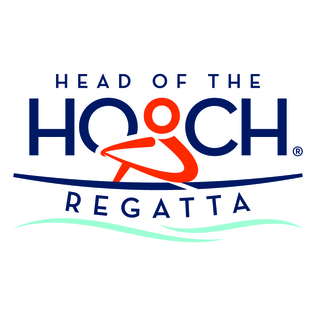
Rowing, often called crew in the United States, is the sport of racing boats using oars. It differs from paddling sports in that rowing oars are attached to the boat using rowlocks, while paddles are not connected to the boat. Rowing is divided into two disciplines: sculling and sweep rowing. In sculling, each rower holds two oars, one in each hand, while in sweep rowing each rower holds one oar with both hands. There are several boat classes in which athletes may compete, ranging from single sculls, occupied by one person, to shells with eight rowers and a coxswain, called eights. There are a wide variety of course types and formats of racing, but most elite and championship level racing is conducted on calm water courses 2 kilometres (1.2 mi) long with several lanes marked using buoys.

Henley Royal Regatta is a rowing event held annually on the River Thames by the town of Henley-on-Thames, England. It was established on 26 March 1839. It differs from the three other regattas rowed over approximately the same course, Henley Women's Regatta, Henley Masters Regatta, and Henley Town and Visitors' Regatta, each of which is an entirely separate event.
The Head of the River is a name given to annual Australian rowing regattas held in South Australia, New South Wales, Victoria, Queensland, Tasmania and Western Australia. The regattas feature competing independent schools, and the winner of the 1st division boys or girls race is crowned the "Head of the River".

The Harvard–Yale Regatta or Yale-Harvard Boat Race is an annual rowing race between the men's heavyweight rowing crews of Harvard University and Yale University. First contested in 1852, it has been held annually since 1859 with exceptions during major wars fought by the United States and the COVID-19 pandemic. The Race is America's oldest collegiate athletic competition, pre-dating The Game by 23 years. It is sometimes referred to as the "Yale-Harvard" regatta, though most official regatta programs brand it "Harvard-Yale".

Vesta Rowing Club is a rowing club based on the Tideway of the River Thames in Putney, London, England. It was founded in 1870.
In competitive rowing, the following specialized terms are important in the corresponding aspects of the sport:

Coastal and offshore rowing is a rowing sport performed at sea. In North America, this sport is often called open water rowing.

Henry (Harry) Clasper was a professional rower and boat builder from Tyneside in England. He was an innovative boat designer who pioneered the development of the racing shell and the use of outriggers. He is said to have invented spoon-shaped oars.

Hampton School Boat Club (HSBC) is the rowing club of Hampton School. Each year the club produces 1st VIIIs that compete at Championship level in the United Kingdom. The club hosts two Head race events each year.

The Boston Rowing Marathon is a rowing head race taking place on the third Sunday of September annually in Lincolnshire, England, over the exceptionally long distance of 49.2 km. The course is along the River Witham from Lincoln to Boston.

The Victorian Head of the River regatta is contested between the eleven Associated Public Schools of Victoria (APS).

Brasenose College Boat Club (BNCBC) is the rowing club of Brasenose College, Oxford, in Oxford, England. It is one of the oldest boat clubs in the world, having beaten Jesus College Boat Club in the first modern rowing race, held at Oxford in 1815. Although rowing at schools such as Eton College and Westminster School predates this, the 1815 contest is the first recorded race between rowing clubs anywhere in the world.
The Thames is one of the main rowing rivers in Europe. Several annual competitions are held along its course, including the Henley Royal Regatta, The Boat Race and other long-distance events, called Head of the River races (Heads).
The Rowing Association of American Colleges the first collegiate athletic organization in the United States, was a body governing college rowing. Upon organization by the captains of the leading crews of the day, they devised a primary rule of eligibility: that only undergraduate students should be eligible to represent their college in the regatta. To this day, despite numerous amendments and additions, this rule remains the very foundation of the NCAA rules of eligibility.

Charles Edward Courtney was an American rower and rowing coach from Union Springs, New York. A carpenter by trade, Courtney was a nationally known amateur rower. Courtney never lost a race as an amateur and finished a total of 88 victories.
David William Crawshay is an Australian former rower, an eleven-time national champion, an Olympic champion and medalist at World Championships. He represented Australia in rowing at three consecutive Olympic games from Athens 2004 to London 2012.

The Ward brothers were four members of one family who rowed, sometimes forming four and two-man crews and sometimes individually. They were declared World Champions after a four-oared race in 1871.

The Head of the Hooch Regatta, previously known as the Head of the Chattahoochee Regatta, is a 2-day rowing regatta held annually on the first full weekend in November in Chattanooga, Tennessee. The head race is currently run downstream on a 3.1 miles (5.0 km) course on the Tennessee River. It presently ranks as one of the largest rowing regattas in the United States with over 10,000 rowers and over 2,100 boats entered for the 2014 event. 1,245 boats raced on one day in the 2012 competition, more than any other US regatta on a single day.

The men's single sculls event at the 2020 Summer Olympics took place from 23 to 30 July 2021 at the Sea Forest Waterway. 32 rowers from 32 nations competed.

The women's single sculls event at the 2020 Summer Olympics took place from 23 to 30 July 2021 at the Sea Forest Waterway. 32 rowers from 32 nations competed.















